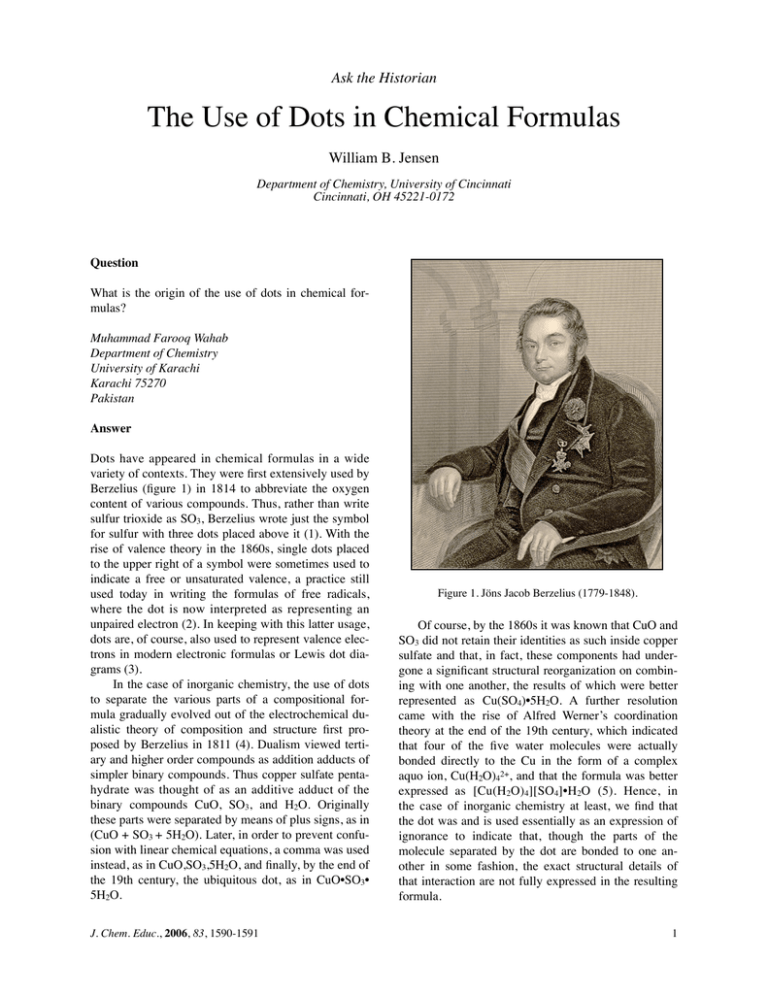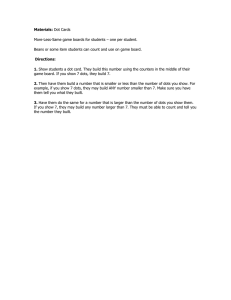134. Dots - University of Cincinnati
advertisement

Ask the Historian The Use of Dots in Chemical Formulas William B. Jensen Department of Chemistry, University of Cincinnati Cincinnati, OH 45221-0172 Question What is the origin of the use of dots in chemical formulas? Muhammad Farooq Wahab Department of Chemistry University of Karachi Karachi 75270 Pakistan Answer Dots have appeared in chemical formulas in a wide variety of contexts. They were first extensively used by Berzelius (figure 1) in 1814 to abbreviate the oxygen content of various compounds. Thus, rather than write sulfur trioxide as SO3, Berzelius wrote just the symbol for sulfur with three dots placed above it (1). With the rise of valence theory in the 1860s, single dots placed to the upper right of a symbol were sometimes used to indicate a free or unsaturated valence, a practice still used today in writing the formulas of free radicals, where the dot is now interpreted as representing an unpaired electron (2). In keeping with this latter usage, dots are, of course, also used to represent valence electrons in modern electronic formulas or Lewis dot diagrams (3). In the case of inorganic chemistry, the use of dots to separate the various parts of a compositional formula gradually evolved out of the electrochemical dualistic theory of composition and structure first proposed by Berzelius in 1811 (4). Dualism viewed tertiary and higher order compounds as addition adducts of simpler binary compounds. Thus copper sulfate pentahydrate was thought of as an additive adduct of the binary compounds CuO, SO3, and H2O. Originally these parts were separated by means of plus signs, as in (CuO + SO3 + 5H2O). Later, in order to prevent confusion with linear chemical equations, a comma was used instead, as in CuO,SO3,5H2O, and finally, by the end of the 19th century, the ubiquitous dot, as in CuO•SO3• 5H2O. J. Chem. Educ., 2006, 83, 1590-1591 Figure 1. Jöns Jacob Berzelius (1779-1848). Of course, by the 1860s it was known that CuO and SO3 did not retain their identities as such inside copper sulfate and that, in fact, these components had undergone a significant structural reorganization on combining with one another, the results of which were better represented as Cu(SO4)•5H2O. A further resolution came with the rise of Alfred Werner’s coordination theory at the end of the 19th century, which indicated that four of the five water molecules were actually bonded directly to the Cu in the form of a complex aquo ion, Cu(H2O)42+, and that the formula was better expressed as [Cu(H2O)4][SO4]•H2O (5). Hence, in the case of inorganic chemistry at least, we find that the dot was and is used essentially as an expression of ignorance to indicate that, though the parts of the molecule separated by the dot are bonded to one another in some fashion, the exact structural details of that interaction are not fully expressed in the resulting formula. 1 WILLIAM B. JENSEN A second use of the dot occurred in the field of organic chemistry, when, beginning in the late 1860s, it became popular to use dots to separate significant structural subunits inside organic molecules when writing linear structural formulas, as in the case of butanoic acid, CH3•CH2•CH2•·COOH (6). Here the dot does not express an absence of structural knowledge, but rather serves as a convenient short hand for breaking the overall molecule into structurally significant fragments. Finally, starting in the 1890s, yet a third use of the dot evolved in connection with the construction of phase diagrams to indicate the formulas of various higher order compounds in terms of the compositions of the binary components used to synthesize them. Thus, in the ternary phase diagram for the limiting components, SiO2, Na2O, and Al2O3, the formulas of the various resulting complex sodium aluminosilicates are all expressed in the form aNa2O•bAl2O3•cSiO2 in which it is implicitly understood that these initial starting components do not exist as such within the resulting compounds or, in other words, that such formulas are devoid of any structural significance. Formulas of this sort are still widely used in the geochemical, glass and ceramics literature (7). In summary, when a dot is used to break a formula into subunits, it may signify ignorance of how the subunits are structurally related, as in our inorganic example; or it may correspond to actual significant structural subunits, as in our organic example; or it may represent the combining ratios of the binary starting materials required for the synthesis of the compound, as in our phase diagram example. Literature Cited 2 1. For details on this particular use of dots, see M. P. Crosland, Historical Studies in the Language of Chemistry, Harvard University Press: Cambridge, MA, 1962, pp. 272274. 2. This particular use of dots was apparently introduced by Kekulé in the 1860s, see C. A. Russell, The History of Valency, Leicester University Press: Leicester, 1971, pp. 226-227, 235. 3. An interesting contemporary account of the rise of electronic dot symbolism can be found in R. M. Caven, J. A. Cranston, Symbols and Formulae in Chemistry: An Historical Study, Blackie: London, 1928, Chapters 6-7. See also reference 2, Chapters 14-15. 4. The combining ratios in the dualistic formulas have been modernized to facilitate comparison with current formulas. Early 19th century formulas often corresponded to fractions or multiples of our current formulas due to the absence of a self-consistent atomic weight scale prior to 1858. 5. A. Werner, New Ideas on Inorganic Chemistry, Longmans, Green & Co: London, 1911. 6. For an early example see, E. Erlenmeyer, Lehrbuch der organischen Chemie, Winter: Leipzig, 1867. In many cases the dots appeared at the base of the symbol rather than being centered half way up. See also reference 3, pp. 88-89. 7. See, for example, W. Vogel, Chemistry of Glass, American Ceramics Society: Columbus, OH, 1985, p. 100; and W. A. Deer, R. A. Howie, J. Zussman, An Introduction to the Rock-Forming Minerals, Wiley: New York, NY, 1966, p. 428. Do you have a question about the historical origins of a symbol, name, concept or experimental procedure used in your teaching? Address them to Dr. William B. Jensen, Oesper Collections in the History of Chemistry, Department of Chemistry, University of Cincinnati, Cincinnati, OH 45221-0172 or e-mail them to jensenwb@ucmail.uc.edu J. Chem. Educ., 2006, 83, 1590-1591
